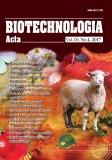ISSN 410-7751 (Print)
ISSN 2410-776X (on-line)

"Biotechnologia Acta" V. 10, No 4, 2017
https://doi.org/10.15407/biotech10.04.053
Р. 53-58, Bibliography 17, English
Universal Decimal Classification: 618.19-002:616.98
BIOMARKERS OF SUBCLINICAL MASTITIS IN THE MAMMARY GLAND OF COWS
V. R. Mazurenko1, 2, O. V. Manchulyak3
1Institute of Biology and Medicine” NSC of Taras Shevchenko Kyiv National University
2“Center for Veterinary Diagnostics”LLC, Kyiv
3“Krasnosilske” DE, “Nadiya” ALLC, “Milkiland Agro”LLC, Ukraine, Chernihiv region
The aim of the study was to create an algorithm for controlling subclinical forms of mastitis of cows on the basis of determining the activity of lactate dehydrogenase and the number of somatic cells in milk. Milk samples were taken from conditionally positive cows according to the results of the California test; the activity of lactate dehydrogenase was determined and compared with the content of somatic cells in milk.
According to the results of the analyzes, 2 out of 20 milk samples had low values of lactate dehydrogenase activity, an increased number of somatic cells (more than 250 000 in 1 ml) and negative results of bacteriological examination, which may indicate on the absence of intra-infection and a physiological increase in the number of secreted somatic cells. With increased lactate dehydrogenase activity and a somatic cell level of no more than 250 000 in 1 ml, Streptococcus agalactiae or Staphylococcus aureus bacteria were isolated, indicating on a mono-infection. At the level of somatic cells from 250 000 to 500 000 in 1 ml (4 of 20 milk samples) bacteria Streptococcus agalactiae and Staphylococcus aureus were isolated, indicative on of mix infections.
Thus, the determination of lactate dehydrogenase activity makes it possible to more accurately determine the presence of inflammatory processes in the udder, since the number of somatic cells can also increase with physiological changes (e. g., stress, etc.). The results obtained can be used to determine the subclinical forms of mastitis in the infected herd. Recommendations developed on the basis of this study were implemented in practice in the economy of the Chernihiv region.
Key words: : subclinical mastitis, lactate dehydroginase, the mammary gland of cow.
© Palladin Institute of Biochemistry of National Academy of Sciences of Ukraine, 2017
References
1. Sharif A., Muhammad G. Mastitis control in dairy animals. Pakistan Vet. J. 2009, 29 (3), 145?148.
2. Sviridenko G. M. The main criterion for the safety of milk-raw animal health. Sal'monellez. Molochnaya promyshlennost. 2009, V. 2, P. 44–46. (In Russian).
3. Chubenko N. V., Malysheva L. A. Procuring the quality and safety of milk and dairy products. Veterinarnaya patologiya. 2012, 39 (1). (In Russian).
4. Balaji Sri N., Saravanan R., Senthilkumar A., Srinivasan G. Effect Of Subclinical Mastitis On Somatic Cell Count And Milk Profile Changes In Dairy Cows. Int. J. Sci., Environm. Technol. 2016, 5 (6), 4427–4431. https://doi.org/10.3168/jds.S0022-0302(97)76118-6
5. Sharma N., Singh N. K., Bhadwal M. S. Relationship of somatic cell count and mastitis: An overview. As.-Austral. J. Anim. Sci. 2011, 24 (3), 429–438. https://doi.org/10.5713/ajas.2011.10233
6. Singh M., Ludri R. S. Somatic cell counts in Murrah buffaloes during different stages of lactation, parity and season. As.-Austral. J. Anim. Sci. 2001, 41 (2), 189–192. https://doi.org/10.5713/ajas.2001.189
7. Schepers A., Lam T., Schukken Y., Wilmink J., Hanekam P. W. Estimation of variance components for somatic cell counts to determine thresholds for uninfected quarters. J. Dairy Sci. 1997, V. 80, P. 1833–1840. https://doi.org/10.3168/jds.S0022-0302(97)76118-6
8. Duarte C. M., Freitas P. P., Bexiga R. Technological advances in bovine mastitis diagnosis: an overview. J. Veterin. Diagnost. Invest. 2015, 27 (6), 665–672. https://doi.org/10.1177/1040638715603087
9. Bortolami A., Fiore E., Gianesella M., Corr? M., Catania S., Morgante M. Evaluation of the udder health status in subclinical mastitis affected dairy cows through bacteriological culture, somatic cell count and thermographic imaging. Polish J. Veterin. Sci. 2015. 18 (4), 799–805. https://doi.org/10.1515/pjvs-2015-0104
10. Koop G., Werven van T., Roffel S., Hogeveen H. Short communication: Protease activity measurement in milk as a diagnostic test for clinical mastitis in dairy cows. J. Dairy Sci. 2015, 98 (7), 4613–4618. https://doi.org/10.3168/jds.2014-8746
11. Silanikove N., Merin U., Leithner G. Physiological role of indigenous milk enzymes. Int. Dairy J. 2006, V. 516, P. 533–554. https://doi.org/10.1016/j.idairyj.2005.08.015
12. Boyso J. O., Alrcon J. J. V., Juarez M. C., Zarzosa A. O., Meza J. E. L., Patino A. B., Aguirre V. M. B. Innate immune response of bovine mammary gland to pathogenic bacteria responsible for mastitis. J. f Infect. 2007, V. 54, P. 399–409. https://doi.org/10.1016/j.jinf.2006.06.010
13. Hiss S., Mueller U., Neu-Zahren A., Sauerwein H. Haptoglobin and lactate dehydrogenase measurements in milk for the identification of subclinically diseased udder quarters. Veterinarni Medicina-Praha. 2007, 52 (6), 245.
14. Larsen T. Determination of lactate dehydrogenase (LDH) activity in milk by a fluorometric assay. J. Dairy Res. 2005, V. 72, P. 209–216. https://doi.org/10.2210/pdb1i10/pdb
15. Chagunda M. G. G., Larsen T., Bjerring M., Ingvartsen L. K. L-lactate dehydrogenase and N-acetyl-b-D-glucosaminidase activities in bovine milk as indicators of non-specific mastitis. J. Dairy Res. 2006, V. 73, P. 431–440. https://doi.org/10.1017/S0022029906001956
16. Mazeris F. DeLaval herd navigator: proactive herd management. Proceedings of First North American Conference on Precision Dairy Management. 2010, 26–27.
17. Hogan, J. S., Gonzalez R. N., Harmon R. J., Nickerson S. C., Oliver S. P., Pankey J. W., Smith K. L. Laboratory Handbook on Bovine Mastitis. Madison, WI: National Mastitis Council. 1999.

